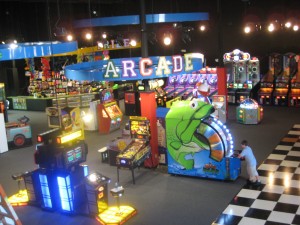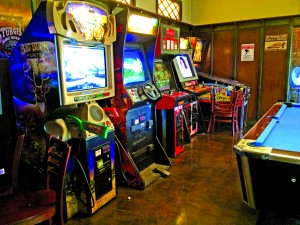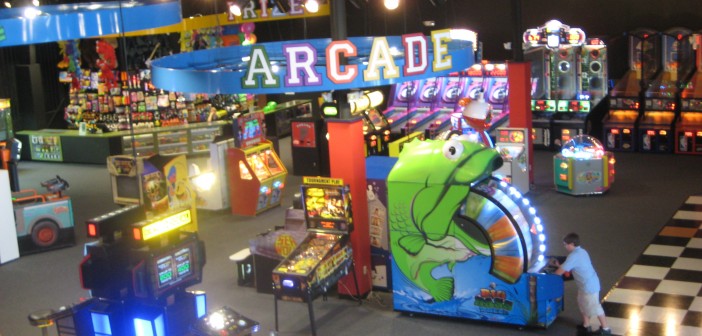Shift to FEC Focus Continues
The Redemption Side of the Industry’s Coin Still Growing

George McAuliffe
By George McAuliffe, Chief FEC Strategist, Redemption Plus
It’s always been a tale of two “industries.” Although many of us use the term “coin-op industry,” it depends on where you come from –– street or arcade –– as to which business model is under discussion. Since the stand-alone arcade is largely dead, that sector is now better known as the family entertainment center or in its shorthand, the FEC.

FECs with redemption (above) now dominate the street route side of the coin machine business (pictured below).
There have always been differences between the street and FEC business models. The street/route business is known for a few games in many locations. FECs are many games in single locations. Street or route operators place equipment in destination locations controlled by others. FECs are the location. Route operators place equipment in the path of traffic to attract incidental and incremental spending. FEC arcades are best integrated into the larger business. Non-redemption games like video, cranes and merchandisers have always driven the route. Redemption dominates the FEC arcade.
An industry shift underway has been happening for thirty years or so and is just now reaching critical mass. On the route side, societal change has played a central role. As U.S. smokers have declined, the cigarette machine that used to be a route staple is essentially gone. Anti-smoking and drunk driving laws changed the bar business, so there are fewer bars in which to place equipment.
 The arcade model has evolved as well. Pinball gave way to video which, for a time in the 1970s and ’80s, was strong enough to attract players to stand-alone arcades. Then came “home video” and the arcade business evolved to redemption games. Redemption games were bigger, plus you needed a redemption center and storage, meaning more space and more line items of expense. The new arcade model didn’t work well in the then-dominant, high-rent mall locations. However, it worked especially well in community-based FECs, and as adjuncts to other businesses such as bowling centers, restaurants, waterparks and major cinema complexes.
The arcade model has evolved as well. Pinball gave way to video which, for a time in the 1970s and ’80s, was strong enough to attract players to stand-alone arcades. Then came “home video” and the arcade business evolved to redemption games. Redemption games were bigger, plus you needed a redemption center and storage, meaning more space and more line items of expense. The new arcade model didn’t work well in the then-dominant, high-rent mall locations. However, it worked especially well in community-based FECs, and as adjuncts to other businesses such as bowling centers, restaurants, waterparks and major cinema complexes.
All three industry tiers –– operators, manufacturers and distributors –– rode this rollercoaster of change together. If we graphed the route and arcade sectors by revenue over the last thirty years, we would see a steady decline of the route line and a steady rise of the arcades. Somewhere in the last five years, those lines crossed; the FEC sector now dominates the business plan of all three tiers.
Surviving game operators have gotten better, have generally become bigger, and have reoriented their management teams, equipment mix and expertise to accommodate the FEC. Not all, of course, with some routes still thriving with music, darts, and even cranes in traditional street locations. There are creative route operators doing well with “Bar Arcade” type stops. But these are the exception. The trend is clear.
Distributor inventory and service models are changing accordingly. Distributors are developing their knowledge base in the art of redemption. They are investing in educating their sales teams to become arcade/FEC centric to better serve the new customer. The ancient rules of territory among distributors are gone and most operate with national or extended regional reach.
In the manufacturing tier, redemption manufacturers have been solid leaders for years now and are enjoying particularly good times these days. After years of decline in revenues and revenue per unit, video games have stabilized and found their level in today’s FEC arcade. Video manufacturers are adapting to the new FEC reality by creating games that are almost attractions in themselves, commanding higher price per play, widening their age and gender appeal, and adapting to the FEC reality. Specialists like photo booth and air hockey creators are doing well.
Perhaps the best example of the industry shift can be seen in the effort underway by AAMA to increase its focus on resources for FECs. I was privileged to serve on the founding board of IALEI, the original FEC association, back in the early 1990s as FECs were just beginning to proliferate. That association was focused on FEC operators and served as an informational clearinghouse for the industry before merging into IAAPA several years ago. AAMA believes that, with a more intense focus on FECs, it can best support its members and the industry at large.
Its first step was to form an FEC committee comprised of game operators, FEC owners, distributors, and manufacturer representatives. Three past presidents of IALEI serve on the committee or executive board (Dorothy Lewis, George Smith and me), and it’s co-chaired by operators Joe Camarota and George Smith. AAMA’s education committee coordinated with this new FEC committee to create the largest number of FEC-focused sessions in the history of the show. (Check out the education sessions for Amusement Expo www.amusementexpo.org.)
The tale of two industries has always been a story of change, innovation and adaptation. The new FEC paradigm is just the latest example of that. The redemption-dominant game room has achieved attraction status (no longer an adjunct to “get the lint out” of customer’s pockets). As the entire industry shifts its focus accordingly we can expect the new cycle of prosperity to continue.
George McAuliffe has operated family entertainment centers from 2,000- to 150,000-sq.-ft. as a corporate executive and entrepreneur. He is currently Chief FEC Strategist for Redemption Plus and leads the company’s strategic advisory team. George, who recently moved back “home” to the Jersey Shore with his wife Julie, has a passion for passing along what he’s learned in the fun business to the new generation of operators and suppliers.
Readers can visit www.grouppinnacle. com for more information, or contact George via email at gmcauliffe@redemptionplus.com or call 913/563-4370.




